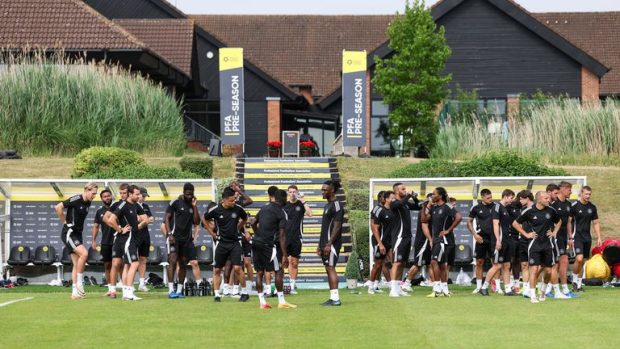The scene, as Chelsea’s players flocked to Estevao at the final whistle at Lincoln Financial Field, was telling. There was a language barrier between them, but Cole Palmer and Liam Delap asked their Portuguese team-mate Dario Essugo to tell the Brazilian teenager just what they thought of him.
That Club World Cup quarter-final was Estevao’s last game for Palmeiras before he joins Chelsea in a transfer worth an initial £29.3million ($40m) and potentially £49m depending on how well he performs at Stamford Bridge. The stunning goal he scored, thrashing the ball past Robert Sanchez from a tight angle, was a parting gift to the Palmeiras fans as well as the perfect getting-to-know-you to his new team-mates and supporters — well, perfect once Chelsea emerged victorious on the night, anyway.
Advertisement
“Congratulations, Chelsea,” Palmeiras coach Abel Ferreira told reporters after Friday’s game. “You have an amazing player.”
There was a slight note of caution. “He is a kid that is 18 years old, so Chelsea need to take care of him,” Ferreira said. “They need to embrace him because in the beginning, for sure, he will make mistakes. I am sure Chelsea have all the conditions to support him. He’s a fantastic player, but he needs the help, for sure.”
From everything we hear out of Chelsea, they are acutely aware of what a special talent they are signing: a precociously gifted forward who made his league debut at 16 and already, just two months past his 18th birthday, has 83 appearances for Palmeiras (and 27 goals) to his name, plus five full caps for Brazil. Chelsea made their move last summer — and everything they have seen over the past 12 months has heightened their belief they have struck gold.

GO DEEPER
Estevao: The Palmeiras prodigy bound for Chelsea who sees the football pitch as his ‘amusement park’
Brazilian clubs and their fans have grown accustomed to waving their most exciting prospects off at a tender age. It is a reality of 21st-century football’s economic landscape, in which players and clubs in South America accept the benefits of a food chain that sucks most of the brightest young talents to Europe. It is one of the reasons why the Brazilian clubs’ relative success at the Club World Cup — Palmeiras reaching the quarter-finals, Fluminense facing Chelsea in Tuesday’s semi-final — has been one of the tournament’s most uplifting aspects.
Chelsea have begun to rival Real Madrid, Benfica and Porto among the most active movers in the Brazilian youth market. In January 2023, they signed midfielder Andrey Santos, then 18, from Vasco da Gama in a projected £18m deal. Six months later they signed forwards Angelo Gabriel and Deivid Washington, both 18 at the time, from Santos in separate deals which, combined, were worth well in excess of £25m to the Brazilian club. Last summer, a deal was struck for Estevao. Corinthians left-back Denner was still 16 in January, yet to make a first-team appearance, when he and his club accepted a deal that will see him move to London after he turns 18.
Advertisement
“It’s not what I wanted,” Corinthians president Augusto Melo told Brazilian website Meu Timao, saying the deal would earn his club a minimum €8m (£6.9m, $9.4m) and potentially up to €15m (£12.9m, $17.6m). “But in the context, it’s an excellent sale.”
Chelsea clearly believe it is excellent business for them too: another addition to the vast number of young players they have signed over the past few seasons. The merits or otherwise of that transfer strategy have been debated at length in these pages; what some of us might see as a stockpiling of young talent, Chelsea and their owners regard as the smartest recruitment model around.

GO DEEPER
Chelsea’s aggressive youth recruitment means days of signing players at peak are over
Estevao looks likely to become the poster boy for that model, a brilliant talent who is already, at 18, one of Brazilian football’s biggest stars. Like Vinicius Junior, Rodrygo and Endrick when they joined Real Madrid from Flamengo, Santos and Palmeiras respectively, all at the age of 18, Estevao is regarded as a player ready to take Europe by storm — even if, as his coach Perreira and his future team-mate Palmer pointed out, there will be times when patience is required.

Endrick is already making a big impression at Real Madrid (Guillermo Martinez/NurPhoto via Getty Images)
The difficulty with this model is not the extreme talents, of which Estevao appears to be one. For every Vinicius Jr or Rodrygo, there are so many more young imports from South America who are signed by big European clubs in a far more speculative manner — and who move to Europe far too early, finding their development stagnates as they go from playing fiercely competitive first-team football in Brazil to coming to terms with being a peripheral member of a bloated squad at a big club in an unfamiliar country, an ocean away from home.
“It works well for the Brazilian clubs, who in some cases are now building their entire business model around selling ‘promises’ to Europe,” says journalist and broadcaster Tim Vickery, who has reported on Brazilian football since moving to the country in 1994. “It has worked extremely well for someone like Vinicius Jr. But there are so many examples of players who jumped way too soon. I feel sorry for some of these players who are surrounded by influences — it can be their club, their agents, members of their family — who only think of the financial benefits to them and don’t think about the player’s career.”
Advertisement
As Vickery puts it, European clubs “all want the next Vini Jr”. He feels Estevao is talented enough to put himself into that category. “But a lot of the young players European clubs sign from Brazil are just punts,” he says. “A lot of them won’t come off. A lot of them are playing first-team football in Brazil at a very young age. Then they’re sold to Europe after a handful of appearances and, in a lot of cases, they struggle.”
One example, Vickery says, is Luis Guilherme, who was signed by West Ham United in June last year in a deal worth £25.5m, having scored one goal in 30 appearances (eight starts, 22 from the bench) for Palmeiras. In his first season at West Ham, the forward sampled just 150 minutes of Premier League football. In his solitary start, away to Wolverhampton Wanderers, he was substituted at half-time. He is still only 19 and was bought with long-term development in mind. But it cannot be easy to develop when, rather than playing first-team football for Palmeiras, you are kicking heels on the bench for a Premier League team, restricted to the odd fleeting cameo.
In April 2021, Manchester City announced the acquisition of Kayky, then 17, who had made his first-team debut for Fluminense just six weeks earlier. He was initially a source of great excitement when he arrived in Manchester, making a couple of brief appearances from the bench, but a couple of loan spells — at Pacos de Ferreira in Portugal and Bahia in Brazil — brought only glimpses of his potential before his career was derailed further by an anterior cruciate ligament injury. He was sold earlier this year to Bahia, who are part of the City Football Group, and is yet to establish himself in their starting line-up.
Another of those Vickery puts in the “punt” category is Washington, who was snapped up by Chelsea after breaking into the first team at Santos in the spring of 2023, scoring against Bahia and Vasco in his first two starts in Brazil’s Serie A.
In his first season at Chelsea, he made three first-team appearances from the bench, but most of his action came for the club’s under-21 team, either in the Premier League’s Professional Development League or against third-tier opposition in the Vertu Trophy. Upon rejoining Santos on loan earlier this year, he told Brazilian reporters he was “coming back at much higher level than in 2023”, but so far nine of his 11 appearances have come from the subs’ bench, which suggests a lack of exposure to first-team football in England has left him battling to get back to his previous level.
Angelo was a “huge hope”, Vickery says, making his Santos debut at 15 and making 129 appearances by the time Chelsea signed him at 18. He impressed in a couple of pre-season matches before being loaned to Strasbourg, also owned by Chelsea’s owner BlueCo, and was then sold at a profit to Saudi Arabian club Al Nassr — nice business for Chelsea and another nice earner for the player, still only 20, but somewhere along the way he lost his place in Brazil’s development teams.
Vickery is effusive about the potential of Santos, who made a big impression on loan at Strasbourg last season, recently won his second Brazil cap and has been part of Chelsea’s Club World Cup squad, acquitting himself well in the quarter-final victory over Palmeiras on Friday. At the same time, he wonders whether the midfielder, now 21, joined the right club in January 2023 given that by the end of the following transfer window they had also committed around £280m to the signings of Enzo Fernandez, Moises Caicedo, Romeo Lavia, Lesley Ugochukwu, of whom Fernandez was the oldest at 22 (now 24). Even if the nature of Chelsea’s recruitment strategy is very clear, the pathway for many of the young players arriving at Stamford Bridge is not.
Advertisement
Chelsea have been through something like this before. If their strategy over the past couple of years is characterised in some quarters as being something new, daring or groundbreaking, it is in part because their previous wave of investments in young Brazilian talent, under Roman Abramovich’s ownership, made so little impact.
There was a strong connection between Chelsea and Brazil during the Abramovich years, in part owing to the relationships between the ownership and some agents who were highly influential in the South American market. Some of the players they signed were already established in Europe, some (such as David Luiz, Ramires, Willian, Diego Costa and Thiago Silva), others (such as Alex and Oscar) were bought straight from Brazil.

GO DEEPER
The end of Chelsea’s Brazilian experiment
But there was also, like now, a concerted investment in teenage Brazilian talent. And it was hugely unsuccessful for club and players alike. Lucas Piazon, Wallace Oliveira, Nathan and Kenedy were all among the brightest prospects when they arrived at Chelsea between 2011 and 2015 from Sao Paulo, Fluminense, Atletico Paranaense and Fluminense respectively. Kenedy fared best by far, but even he only managed as many Premier League starts (six) as loan spells in his seven years on Chelsea’s books.
The combined Chelsea experience of that quartet amounts to 26 years, 22 loan spells and only 43 appearances (40 of which were by Kenedy). Wallace and Nathan never played a first-team game. Absurdly, by the time he left the club in 2021, Lucas Piazon was their longest-serving player but had not made a first-team appearance for almost nine years. By 2019, on his eighth loan spell, he told Portuguese newspaper A Bola he was “tired” of the whole experience and that “there comes a time in your career when that makes no sense anymore”. Rather than blame Chelsea, he blamed himself for believing there was a pathway for him when, in hindsight, he could see there was not.

Lucas Piazon was at Chelsea from 2012 until 2021, spending the vast majority of that time on loan at seven different clubs (Sam Barnes/Sportsfile via Getty Images)
So, no, there is nothing new about accumulating vast numbers of young players from Brazil and elsewhere, securing them on long-term contracts and loaning them out again and again in the hope that one or two of them will develop into first-team players — all at the same time as continuing to make expensive additions to the first-team squad, which leads to a situation where the pathway becomes more and more congested every year.
Piazon eventually moved on to Braga and, at 31, is still in Portugal with AVS. Nathan, 29, is now back in Brazil and on the fringes of the squad at Gremio. Kenedy, also 29, was recently loaned from Spain’s Real Valladolid to Mexican club Pachuca, for whom he appeared in the Club World Cup group stage. There is little trace of Wallace, 31, since a brief spell at Brazilian club Sampaio Correa-RJ. Of the 90 appearances listed on his career profile on Transfermarkt, 30 were for Fluminense before he left for Chelsea at 18.
Vickery is asked whether players like Piazon, Kenedy, Wallace and Nathan are cited as cautionary tales in Brazil. “Not really,” he says. “They hadn’t really done anything here in Brazil. Talented players, but they were ‘promises’ rather than ‘realities’. Even if it’s the right player going to the right club, nothing is certain. But if it’s the right player going to the wrong club at the wrong time… .”
Advertisement
Estevao is a different matter entirely, he says. Endrick likewise. These are extreme talents who, all things being equal, already look equipped to thrive in European football. But still, something nags. Is Chelsea the right club for Estevao? Is Real Madrid the right club for Endrick? It could be, in both cases, but both have joined clubs where there is such an array of attacking talent and such intense competition for a starting place.
There was something striking that Estevao’s agent Andre Cury said in March about the reason his client chose Chelsea, telling Ge Globo they were “the only club that saw (Estevao) as a No 10”, i.e. playing in a central role rather than on the wing.
Cury added he “might be wrong” about that, but that only heightens the sense of confusion about just how Chelsea plan to accommodate all these young attacking players, given that Enzo Fernandez, Palmer and new signing Joao Pedro might have designs on that No 10 role, as well as different interpretations as to how to play it.
For the immediate future, Estevao looks a better bet for the right wing. But then so does Portugal international Pedro Neto, a £54m acquisition from last summer. And so does Ecuador international Kendry Paez, 18, who has just arrived from Independiente del Valle and is expected to join Strasbourg on loan. And so does Portugal Under-21 international Geovany Quenda, also 18, who will arrive from Sporting next summer. And when clubs object to the use of the word “stockpiling”, it comes back to the question of how many of the world’s best teenagers any one club needs in one position — and whether such recruitment strategies, not unique to Chelsea, are healthy for the game or for the players in question.
In many ways, Joao Pedro is the most fascinating counterpoint to all of this. He was not regarded in Brazil as an elite talent when he left Fluminense for Watford as an 18-year-old in January 2020. It was the type of deal that easily could have gone wrong given the managerial turnover at Vicarage Road, but he made a success of the move and then did likewise at Brighton & Hove Albion. He has joined Chelsea at 23 with more than 200 career appearances to his name — a markedly different career trajectory to some of those who have gone straight to the biggest clubs and missed an important stage of their development.
Another counterpoint is Fluminense forward Jhon Arias, who has been one of the outstanding performers at this Club World Cup but, at 27, is a relatively late bloomer in his native Colombia and might find it is too late to secure a move to a big European club even if he wishes to.
“The big European clubs don’t want to sign the best players in South America anymore,” Vickery says. “They’re not looking at the likes of Jhon Arias. They want the best prospects, not the best players. They want to get them in their club or in their structure now, when they’re young — rather than letting Benfica, Porto, Brighton or whoever sign them and then ending up paying £60m for them in a couple of years’ time.”
Advertisement
There is a certain business logic to that; from a cynical perspective, if a £10m investment fails to live up to expectations, the financial downside for the buying club is relatively small — and in many cases, he will be sold to a club lower down the food chain. That risk is reduced further if, for example, a club is able to sell to another club in the same ownership group, as with Manchester City selling Kayky to Bahia or Chelsea selling to Strasbourg after the Portugal Under-21 international Diego Moreira had made a solitary Carabao Cup appearance for the club.
But inevitably, there can be collateral damage to some of these players’ careers. Some of them might be inclined to look at what Flamengo, Palmeiras and Fluminense have done at this Club World Cup and wonder whether their careers would have been better served by staying in Brazil a little longer — even if their bank balances might not.
The reality is that not every player is a Vinicius Jr. These players are exceptions rather than the rule. Chelsea have every reason to believe they have found another such exception in Estevao. But that is unlikely to deter them whenever the next hot prospect in Brazilian football emerges, which is usually any minute now.
(Top photo: Jonathan Moscrop/Getty Images)
This news was originally published on this post .





Be the first to leave a comment